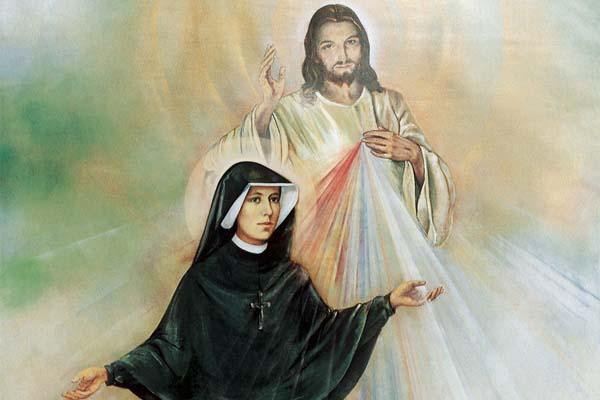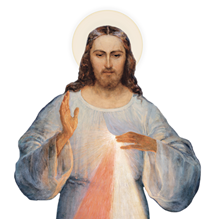
A weekly series by Robert Stackpole, STD, the Director of the John Paul II Institute of Divine Mercy
WEEK 13: The Cross and the Resurrection
Although the message of Divine Mercy is prominent in the teachings of Jesus, and expressed through His works of healing throughout His Galilean ministry, the gospel writers emphasize that it is the Cross and the Resurrection of Jesus, above all, that is the most decisive breakthrough of God's merciful love in this fallen world.
For example, after St. Peter's confession of faith in Christ in chapter 9 of St. Luke's gospel, the rest of the book tells the story of Jesus' final missionary walk from Galilee to Jerusalem, His arrest, trial, crucifixion and resurrection. In other words, the story of the Cross and of Easter really begins at Lk. 9:22, and continues right to the end of the gospel in chapter 24! This clearly illustrates the overwhelming importance of these events in the story of God's merciful love that Luke is narrating.
When our Lord was dying on the Cross, He never ceased to shower his merciful love upon those around Him. For example, He prayed for His persecutors: "Father forgive them, for they know not what they do" (Lk. 23:34). He gave the hope of pardon and eternal peace to the penitent thief crucified alongside Him: "Truly I say to you, today you shall be with me in paradise" (Lk. 23:43). He even made provision for the care of His mother from the Cross, and gave her to us as Mother of all Christians: "Woman, behold your son...son, behold your mother!" (Jn. 19:26-27).
The theology embedded in the gospel also points to the importance of the paschal mystery as the supreme revelation of Divine Mercy. First of all, Jesus is shown to be the divine Son of God Himself in human flesh, giving His life for the salvation of the world. This clearly shows that in His very depths God is merciful love. (Note: That is why the gospels are careful to report to us that at the moment of Jesus' death, the curtain of the Temple in Jerusalem was torn in two from top-to-bottom, revealing the Holy of Holies as Divine Love. Interestingly, this is not just theological symbolism: historical reportage from that era from outside the gospels confirms that this mysterious tearing of the Temple curtain really took place!). By dying on the Cross for us, Jesus satisfied the requirements of Divine Justice for us - but He went way beyond justice, obtaining for us an infinite ocean of graces of His merciful love.
Pope St. John Paul II explained this well in Dives in Misericordia, section 7:
In the Passion and Death of Christ - in the fact that the Father did not spare His own Son, but "for our sake made him sin" - absolute justice is expressed, for Christ undergoes the passion and cross because of the sins of humanity. This constitutes even a "superabundance" of justice, for the sins of man are "compensated for" by the sacrifice of the Man-God. Nevertheless, this justice, which is properly justice "to God's measure," springs completely from love: from the love of the Father and the Son, and completely bears fruit in love....The divine dimension of the redemption is put into effect not only by bringing justice to bear upon sin, but also by restoring to love that creative power in man thanks to which he once more has access to the fullness of life and holiness that come from God. In this way, redemption involves the revelation of mercy in its fullness.
According to the Holy Father, the Resurrection too is a testimony to Divine Mercy through and through. For the Resurrection shows us not only that Christ's love was more powerful than sin and death, but more powerful than OUR sin and OUR death! His resurrection is for US, not just for Himself: He rises to new life in order to be with us always, to the end of time (Mt. 28:20), to fill us with His new life and thereby enable us to share in His Easter triumph. The Pope writes of this in that same encyclical, section 8:
Here is the Son of God, who in His resurrection experienced in a radical way mercy shown to Himself - that is to say, the love of the Father, which is more powerful than death. And it is also the same Christ, the Son of God, who at the end of His messianic mission... reveals Himself as the inexhaustible source of mercy, of the same love that, in a subsequent perspective of the history of salvation in the Church, is to be everlastingly confirmed as more powerful than sin. The paschal Christ is the definitive incarnation of mercy.... In the same spirit, the liturgy of Eastertide places on our lips the words of the psalm: "Misericordia Domini in aeternum cantabo."
"I will sing of the mercies of the Lord forever!"
This series continues next week on the theme, "The Mercy Message of St. Peter and St. Paul."
Robert Stackpole, STD, is the director of The John Paul II Institute of Divine Mercy.
{shopmercy-ad}

















